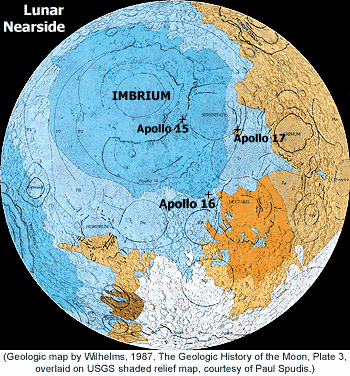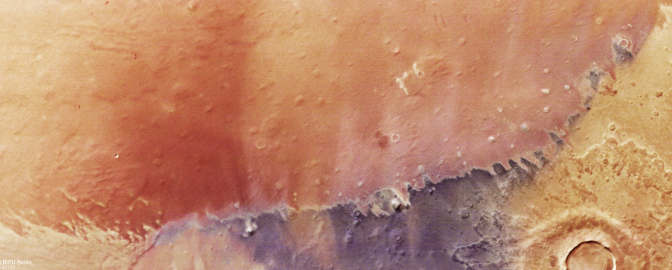Relative and absolute ages in the histories of Earth and the Moon: The Geologic Time Scale

Written by
Emily Lakdawalla
September 30, 2013
A few days ago, I wrote a post about the basins of the Moon -- a result of a trip down a rabbit hole of book research. Here's the next step in that journey: the Geologic Time Scales of Earth and the Moon.
In the science of geology, there are two main ways we use to describe how old a thing is or how long ago an event took place. There are absolute ages and there are relative ages.
People love absolute ages. An absolute age is a number. When you say that I am 38 years old or that the dinosaurs died out 65 million years ago, or that the solar system formed 4.6 billion years ago, those are absolute ages. We use a variety of laboratory techniques to figure out absolute ages of rocks, often having to do with the known rates of decay of radioactive elements into detectable daughter products.
Unfortunately, those methods don't work on all rocks, and they don't work at all if you don't have rocks in the laboratory to age-date. There's no absolute age-dating method that works from orbit, and although scientists are working on age-dating instruments small enough to fly on a lander (I'm looking at you, Barbara Cohen), nothing has launched yet.
So that leaves us with relative ages. Relative ages are not numbers. They are descriptions of how one rock or event is older or younger than another. Relative age dating has given us the names we use for the major and minor geologic time periods we use to split up the history of Earth and all the other planets. When you talk about the Precambrian, Paleozoic, Mesozoic, and Cenozoic on Earth, or the Noachian, Hesperian, and Amazonian for Mars, these are all relative ages.
Relative-age time periods are what make up the Geologic Time Scale. The Geologic Time Scale is up there with the Periodic Table of Elements as one of those iconic, almost talismanic scientific charts. Long before I understood what any of it meant, I'd daydream in science class, staring at this chart, sounding out the names, wondering what those black-and-white bars meant, wondering what the colors meant, wondering why the divisions were so uneven, knowing it represented some kind of deep, meaningful, systematic organization of scientific knowledge, and hoping I'd have it all figured out one day.

This all has to do with describing how long ago something happened. But how do we figure out when something happened? There are several ways we figure out relative ages. The simplest is the law of superposition: if thing A is deposited on top of (or cuts across, or obliterates) thing B, then thing B must have been there already when thing A happened, so thing B is older than thing A. We have no idea how much older thing B is, we just know that it's older. That's why geologic time is usually diagramed in tall columnar diagrams like this. Just like a stack of sedimentary rocks, time is recorded in horizontal layers, with the oldest layer on the bottom, superposed by ever-younger layers, until you get to the most recent stuff on the tippy top.
On Earth, we have a very powerful method of relative age dating: fossil assemblages. Paleontologists have examined layered sequences of fossil-bearing rocks all over the world, and noted where in those sequences certain fossils appear and disappear. When you find the same fossils in rocks far away, you know that the sediments those rocks must have been laid down at the same time. The more fossils you find at a location, the more you can fine-tune the relative age of this layer versus that layer. Of course, this only works for rocks that contain abundant fossils. Conveniently, the vast majority of rocks exposed on the surface of Earth are less than a few hundred million years old, which corresponds to the time when there was abundant multicellular life here. Look closely at the Geologic Time Scale chart, and you might notice that the first three columns don't even go back 600 million years. That last, pink Precambrian column, with its sparse list of epochal names, covers the first four billion years of Earth's history, more than three quarters of Earth's existence. Most Earth geologists don't talk about that much.
Paleontologists have used major appearances and disappearances of different kinds of fossils on Earth to divide Earth's history -- at least the part of it for which there are lots of fossils -- into lots of eras and periods and epochs. When you talk about something happening in the Precambrian or the Cenozoic or the Silurian or Eocene, you are talking about something that happened when a certain kind of fossil life was present. Major boundaries in Earth's time scale happen when there were major extinction events that wiped certain kinds of fossils out of the fossil record. This is called the chronostratigraphic time scale -- that is, the division of time (the "chrono-" part) according to the relative position in the rock record (that's "stratigraphy").
The science of paleontology, and its use for relative age dating, was well-established before the science of isotopic age-dating was developed. Nowadays, age-dating of rocks has established pretty precise numbers for the absolute ages of the boundaries between fossil assemblages, but there's still uncertainty in those numbers, even for Earth. In fact, I have sitting in front of me on my desk a two-volume work on The Geologic Time Scale 2012, fully 1500 pages devoted to an eight-year effort to fine-tune the correlation between the relative time scale and the absolute time scale. The Geologic Time Scale is not light reading, but I think that every Earth or space scientist should have a copy in his or her library -- and make that the latest edition. In the time since the previous geologic time scale was published in 2004, most of the boundaries between Earth's various geologic ages have shifted by a million years or so, and one of them (the Carnian-Norian boundary within the late Triassic epoch) has shifted by 12 million years. With this kind of uncertainty, Felix Gradstein, editor of the Geologic Time Scale, suggests that we should stick with relative age terms when describing when things happened in Earth's history (emphasis mine):
For clarity and precision in international communication, the rock record of Earth's history is subdivided into a "chronostratigraphic" scale of standardized global stratigraphic units, such as "Devonian", "Miocene", "Zigzagiceras zigzag ammonite zone", or "polarity Chron C25r". Unlike the continuous ticking clock of the "chronometric" scale (measured in years before the year AD 2000), the chronostratigraphic scale is based on relative time units in which global reference points at boundary stratotypes define the limits of the main formalized units, such as "Permian". The chronostratigraphic scale is an agreed convention, whereas its calibration to linear time is a matter for discovery or estimation.
Got that? We can all agree (to the extent that scientists agree on anything) to the fossil-derived scale, but its correspondence to numbers is a "calibration" process, and we must either make new discoveries to improve that calibration, or estimate as best we can based on the data we have already.
To show you how this calibration changes with time, here's a graphic developed from the previous version of The Geologic Time Scale, comparing the absolute ages of the beginning and end of the various periods of the Paleozoic era between 1937 and 2004. (I tip my hat to Chuck Magee for the pointer to this graphic.)
Fossils give us this global chronostratigraphic time scale on Earth. On other solid-surfaced worlds -- which I'll call "planets" for brevity, even though I'm including moons and asteroids -- we haven't yet found a single fossil. Something else must serve to establish a relative time sequence.
That something else is impact craters. Earth is an unusual planet in that it doesn't have very many impact craters -- they've mostly been obliterated by active geology. Venus, Io, Europa, Titan, and Triton have a similar problem. On almost all the other solid-surfaced planets in the solar system, impact craters are everywhere. The Moon, in particular, is saturated with them.
We use craters to establish relative age dates in two ways. If an impact event was large enough, its effects were global in reach. For example, the Imbrium impact basin on the Moon spread ejecta all over the place. Any surface that has Imbrium ejecta lying on top of it is older than Imbrium. Any craters or lava flows that happened inside the Imbrium basin or on top of Imbrium ejecta are younger than Imbrium. Imbrium is therefore a stratigraphic marker -- something we can use to divide the chronostratigraphic history of the Moon.

The other way we use craters to age-date surfaces is simply to count the craters. At its simplest, surfaces with more craters have been exposed to space for longer, so are older, than surfaces with fewer craters. Of course the real world is never quite so simple. There are several different ways to destroy smaller craters while preserving larger craters, for example. Despite problems, the method works really, really well.
Most often, the events that we are age-dating on planets are related to impacts or volcanism. Volcanoes can spew out large lava deposits that cover up old cratered surfaces, obliterating the cratering record and resetting the crater-age clock. When lava flows overlap, it's not too hard to use the law of superposition to tell which one is older and which one is younger. If they don't overlap, we can use crater counting to figure out which one is older and which one is younger. In this way we can determine relative ages for things that are far away from each other on a planet. Interleaved impact cratering and volcanic eruption events have been used to establish a relative time scale for the Moon, with names for periods and epochs, just as fossils have been used to establish a relative time scale for Earth.
The Geologic Time Scale contains a chapter about planetary time scales, written by Ken Tanaka and Bill Hartmann. The chapter draws on five decades of work going right back to the origins of planetary geology. The Moon's history is divided into pre-Nectarian, Nectarian, Imbrian, Eratosthenian, and Copernican periods (from oldest to youngest).
The oldest couple of chronostratigraphic boundaries are defined according to when two of the Moon's larger impact basins formed: older Nectaris and younger Imbrium. There were many impacts before Nectaris, in the pre-Nectarian period (including 30 major impact basins), and there were many more that formed in the Nectarian period, the time between Nectaris and Imbrium. The Orientale impact happened shortly after the Imbrium impact, and that was pretty much it for major basin-forming impacts on the Moon. I talked about all of these basins in my previous blog post.

There was some volcanism happening during the Nectarian and early Imbrian period, but it really got going after Orientale. Vast quantities of lava erupted onto the Moon's nearside, filling many of the older basins with dark flows. So the Imbrian period is divided into the Early Imbrian epoch -- when Imbrium and Orientale formed -- and the Late Imbrian epoch -- when most mare volcanism happened. People have done a lot of work on crater counts of mare basalts, establishing a very good relative time sequence for when each eruption happened.

Over time, mare volcanism waned, and the Moon entered a period called the Eratosthenian -- but where exactly this happened in the record is a little fuzzy. Tanaka and Hartmann lament that Eratosthenes impact did not have widespread-enough effects to allow global relative age dating -- but neither did any other crater; there are no big impacts to use to date this time period. Tanaka and Hartmann suggest that the decline in mare volcanism -- and whatever impact crater density is associated with the last gasps of mare volcanism -- would be a better marker than any one impact crater.
Most recently, a few late impact craters, including Copernicus, spread bright rays across the lunar nearside. Presumably older impact craters made pretty rays too, but those rays have faded with time. Rayed craters provide another convenient chronostratigraphic marker and therefore the boundary between the Eratosthenian and Copernican eras.

Here is a graphic showing the chronostratigraphy for the Moon -- our story for how the Moon changed over geologic time, put in graphic form. Basins and craters dominate the early history of the Moon, followed by mare volcanism and fewer craters.

So: when did all of this happen, exactly? Can we put absolute ages on this time scale? Well, we can certainly try. The Moon is the one planet other than Earth for which we have rocks that were picked up in known locations. We also have several lunar meteorites to play with.
Most moon rocks are very old. All the Apollo missions brought back samples of rocks that were produced or affected by the Imbrium impact, so we can confidently date the Imbrium impact to about 3.8 billion years ago, meaning that most of the Moon's surface is super old. And we can pretty confidently date mare volcanism for each of the Apollo and Luna landing sites -- that was happening around 3.3 to 3.1 billion years ago. Not quite as old, but still pretty old.

Beyond that, the work to pin numbers on specific events gets much harder. There is an enormous body of science on the age-dating of Apollo samples and Moon-derived asteroids. We have a lot of rock samples and a lot of derived ages, but it's hard to be certain where a particular chunk of rock picked up by an astronaut originated. The Moon's surface has been so extensively "gardened" over time by smaller impacts that there was no intact bedrock available to the Apollo astronauts to sample. And it's impossible to know where a lunar meteorite originated. So we can get incredibly precise dates on the ages of these rocks, but can't really know for sure what we're dating.
Consequently, there is a lot of uncertainty about the ages of even the biggest events in the Moon's history, like the Nectarian impact. There's some evidence suggesting that it's barely older than Imbrium, which means that there was a period of incredibly intense asteroid impacts -- the Late Heavy Bombardment. There are other people who argue that the rocks we think are from the Nectaris are either actually from Imbrium or were affected by Imbrium, so that we don't actually know when Nectaris happened and consequently can't say for sure whether the Late Heavy Bombardment happened. Dating lunar asteroids doesn't help; none have been found that are older than 3.9 to 4 billion years old, so all we can say is that we simply don't have any data from that period. After writing a lengthy article for Sky & Telescope on the science behind the Late Heavy Bombardment I'm agnostic about the question of its existence. It seems like there's a lot of evidence supporting the idea that it happened, and there's a workable explanation of why it might have happened, but there's a problematic lack of geologic record for the time before it happened.
But we do the best we can with what we've got. Here is the same diagram I showed above, but this time I've squished and stretched parts of it to fit a linear time scale on the right. I drew in a billion years' worth of lines for the boundary between the Eratosthenian and Copernican ages, because we really don't have data that tells us where precisely to draw that line. Look how squished the Moon's history is! Almost all the cratering happened in the bottom bit of the diagram. The volcanism pretty much ended halfway through the Moon's history. For more than two billion years -- half the diagram -- almost no action. A crater here, a little squirt of volcanism there.
That stack of numbers on the right side of the diagram is comforting; it seems like we've got a good handle on the history of the Moon if we can label it so neatly. But it's really not nearly as neat as the crisp lines on this diagram make it seem. Most of the events on the list could move up and down the absolute time scale quite a lot as we improve our calibration of the relative time scale.
When I write for magazines, my editors always ask me to put absolute numbers on the dates of past events. I absolutely hate absolute ages in planetary science, because their precision is illusory, even for a place like the Moon for which we have quite a lot of returned samples. It gets much, much worse for other worlds. Relative ages are more accurate, among scientists anyway. The public wouldn't know what I meant if I said "Nectarian" or "Imbrian." But if I say that an event dates back to the time that the Moon was getting hammered by huge impacts, or if it dated back to the time after the impacts when the mare lavas were flowing out on to the Moon's surface, in either case the event would have taken place billions of years ago; and that's precise enough for almost any public communication purpose.
If the ages are so uncertain for the Moon, what about the ages of Mars and Mercury? I'll leave those for another day....
Support our core enterprises
Your gift today will go far to help us close out the year strong and keep up our momentum in 2026.
Donate

 Explore Worlds
Explore Worlds Find Life
Find Life Defend Earth
Defend Earth


